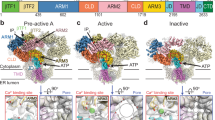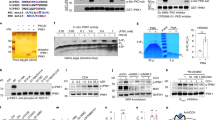Abstract
Receptor-mediated generation of inositol 1,4,5-trisphosphate (InsP3) initiates Ca2+ release from intracellular stores and the subsequent activation of store-operated calcium influx1. InsP3 is metabolized within seconds by 5-phosphatase and 3-kinase2, yielding Ins(1,4)P2 and inositol 1,3,4,5-tetrakisphosphate (InsP4), respectively. Some studies have suggested that InsP4 controls Ca2+ influx in combination with InsP3 (refs 3 and 4), but another study did not find the same result5. Some of the apparent conflicts between these previous studies have been resolved6; however, the physiological function of InsP4 remains elusive7,8. Here we have investigated the function of InsP4 in Ca2+ influx in the mast cell line RBL-2H3, and we show that InsP4 inhibits InsP3 metabolism through InsP3 5-phosphatase, thereby facilitating the activation of the store-operated Ca2+ current ICRAC (ref. 9). Physiologically, this mechanism opens a discriminatory time window for coincidence detection that enables selective facilitation of Ca2+ influx by appropriately timed low-level receptor stimulation. At higher concentrations, InsP4 acts as an inhibitor of InsP3 receptors, enabling InsP4 to act as a potent bi-modal regulator of cellular sensitivity to InsP3, which provides both facilitatory and inhibitory feedback on Ca2+ signalling.
This is a preview of subscription content, access via your institution
Access options
Subscribe to this journal
Receive 51 print issues and online access
$199.00 per year
only $3.90 per issue
Buy this article
- Purchase on Springer Link
- Instant access to full article PDF
Prices may be subject to local taxes which are calculated during checkout





Similar content being viewed by others
References
Parekh, A. B. & Penner, R. Store depletion and calcium influx. Physiol. Rev. 77, 901–930 (1997).
Connolly, T. M., Bansal, V. S., Bross, T. E., Irvine, R. F. & Majerus, P. W. The metabolism of tris- and tetraphosphates of inositol by 5-phosphomonoesterase and 3-kinase enzymes. J. Biol. Chem. 262, 2146–2149 (1987).
Irvine, R. F. & Moor, R. M. Micro-injection of inositol 1,3,4,5-tetrakisphosphate activates sea urchin eggs by a mechanism dependent on external Ca2+. Biochem. J. 240, 917–920 (1986).
Morris, A. P., Gallacher, D. V., Irvine, R. F. & Petersen, O. H. Synergism of inositol trisphosphate and tetrakisphosphate in activating Ca2+-dependent K+ channels. Nature 330, 653–655 (1987).
Bird, G. S. et al. Activation of Ca2+ entry into acinar cells by a non-phosphorylatable inositol trisphosphate. Nature 352, 162–165 (1991).
Smith, P. M., Harmer, A. R., Letcher, A. J. & Irvine, R. F. The effect of inositol 1,3,4,5-tetrakisphosphate on inositol trisphosphate-induced Ca2+ mobilization in freshly isolated and cultured mouse lacrimal acinar cells. Biochem. J. 347, 77–82 (2000).
Fukuda, M. & Mikoshiba, K. The function of inositol high polyphosphate binding proteins. BioEssays 19, 593–603 (1997).
Cullen, P. J. Bridging the GAP in inositol 1,3,4,5-tetrakisphosphate signalling. Biochim. Biophys. Acta 1436, 35–47 (1998).
Hoth, M. & Penner, R. Depletion of intracellular calcium stores activates a calcium current in mast cells. Nature 355, 353–356 (1992).
Parekh, A. B., Fleig, A. & Penner, R. The store-operated calcium current ICRAC: nonlinear activation by InsP3 and dissociation from calcium release. Cell 89, 973–980 (1997).
Broad, L. M., Armstrong, D. L. & Putney, J. W. Role of the inositol 1,4,5-trisphosphate receptor in Ca2+ feedback Inhibition of calcium release-activated calcium current ICRAC. J. Biol. Chem. 274, 32881–32888 (1999).
Glitsch, M. D. & Parekh, A. B. Ca2+ store dynamics determines the pattern of activation of the store-operated Ca2+ current ICRAC in response to InsP3 in rat basophilic leukaemia cells. J. Physiol. (Lond.) 523, 283–290 (2000).
Jones, S. V., Choi, O. H. & Beaven, M. A. Carbachol induces secretion in a mast cell line (RBL-2H3) transfected with the M1 muscarinic receptor gene. FEBS Lett. 289, 47–50 (1991).
Lewis, R. S. & Cahalan, M. D. Potassium and calcium channels in lymphocytes. Annu. Rev. Immunol. 13, 623–653 (1995).
Hirata, M. et al. Inositol 1,4,5-trisphosphate receptor subtypes differentially recognize regioisomers of D-myo-inositol 1,4,5-trisphosphate. Biochem. J. 328, 93–98 (1997).
Guillemette, G., Favreau, I., Lamontagne, S. & Boulay, G. 2,3-Diphosphoglycerate is a nonselective inhibitor of inositol 1,4,5-trisphosphate action and metabolism. Eur. J. Pharmacol. 188, 251–260 (1990).
Safrany, S. T. et al. Design of potent and selective inhibitors of myo-inositol 1,4,5-trisphosphate 5-phosphatase. Biochemistry 33, 10763–10769 (1994).
Wojcikiewicz, R. J. Type I, II, and III inositol 1,4,5-trisphosphate receptors are unequally susceptible to down-regulation and are expressed in markedly different proportions in different cell types. J. Biol. Chem. 270, 11678–11683 (1995).
De Smedt, H. et al. Determination of relative amounts of inositol trisphosphate receptor mRNA isoforms by ratio polymerase chain reaction. J. Biol. Chem. 269, 21691–21698 (1994).
Bird, G. S. & Putney, J. W. Jr. Effect of inositol 1,3,4,5-tetrakisphosphate on inositol trisphosphate-activated Ca2+ signaling in mouse lacrimal acinar cells. J. Biol. Chem. 271, 6766–6770 (1996).
Communi, D., Dewaste, V. & Erneux, C. Calcium-calmodulin-dependent protein kinase II and protein kinase C- mediated phosphorylation and activation of D-myo-inositol 1,4,5-trisphosphate 3-kinase B in astrocytes. J. Biol. Chem. 274, 14734–14742 (1999).
De Smedt, F. et al. Isoprenylated human brain type I inositol 1,4,5-trisphosphate 5- phosphatase controls Ca2+ oscillations induced by ATP in Chinese hamster ovary cells. J. Biol. Chem. 272, 17367–17375 (1997).
Parekh, A. B. & Penner, R. Depletion-activated calcium current is inhibited by protein kinase in RBL-2H3 cells. Proc. Natl Acad. Sci. USA 92, 7907–7911 (1995).
Hughes, A. R., Takemura, H. & Putney, J. W. Jr. Kinetics of inositol 1,4,5-trisphosphate and inositol cyclic 1:2,4,5-trisphosphate metabolism in intact rat parotid acinar cells. Relationship to calcium signalling. J. Biol. Chem. 263, 10314–10319 (1988).
da Silva, C. P., Emmrich, F. & Guse, A. H. Adriamycin inhibits inositol 1,4,5-trisphosphate 3-kinase activity in vitro and blocks formation of inositol 1,3,4,5-tetrakisphosphate in stimulated Jurkat T-lymphocytes. Does inositol 1,3,4,5-tetrakisphosphate play a role in Ca2+-entry? J. Biol. Chem. 269, 12521–12526 (1994).
Balla, T. et al. Agonist-induced calcium signaling is impaired in fibroblasts overproducing inositol 1,3,4,5-tetrakisphosphate. J. Biol. Chem. 266, 24719–24726 (1991).
Riley, A. M., Mahon, M. F. & Potter, B. V. L. Rapid synthesis of the enantiomers of myo-inositol 1,3,4,5-tetrakisphosphate by direct chiral desymmetrization of myo-inositol orthoformate. Angew. Chem. Int. Edn. Eng. 36, 1472–1474 (1997).
Yoshimura, K., Watanabe, Y., Erneux, C. & Hirata, M. Use of phosphorofluoridate analogues of D-myo-inositol 1,4,5-trisphosphate to assess the involvement of ionic interactions in its recognition by the receptor and metabolising enzymes. Cell. Signal. 11, 117–125 (1999).
Worley, P. F., Baraban, J. M., Supattapone, S., Wilson, V. S. & Snyder, S. H. Characterization of inositol trisphosphate receptor binding in brain. Regulation by pH and calcium. J. Biol. Chem. 262, 12132–12136 (1987).
Acknowledgements
We would like to thank D. Tani and M. Monteilh-Zoller for technical assistance; C. Erneux for the InsP3 5-phosphatase plasmid ECH10; the Wellcome Trust for Programme Grant Support (to B.V.L.P.). We acknowledge grant support by the Ministry of Education, Science, Sports and Culture of Japan (to H.T. and M.H.), Kyushu University Interdisciplinary Programs in Education and Projects in Research Development (to M.H.) and The Naito Foundation (to M.H.).
Author information
Authors and Affiliations
Corresponding author
Rights and permissions
About this article
Cite this article
Hermosura, M., Takeuchi, H., Fleig, A. et al. InsP4 facilitates store-operated calcium influx by inhibition of InsP3 5-phosphatase. Nature 408, 735–740 (2000). https://doi.org/10.1038/35047115
Received:
Accepted:
Issue Date:
DOI: https://doi.org/10.1038/35047115
This article is cited by
-
Substrate promiscuity of inositol 1,4,5-trisphosphate kinase driven by structurally-modified ligands and active site plasticity
Nature Communications (2024)
-
ITPKA expression is a novel prognostic factor in hepatocellular carcinoma
Diagnostic Pathology (2015)
-
Transgenic expression of ThIPK2 gene in soybean improves stress tolerance, oleic acid content and seed size
Plant Cell, Tissue and Organ Culture (PCTOC) (2012)
-
Regulation of immune cell development through soluble inositol-1,3,4,5-tetrakisphosphate
Nature Reviews Immunology (2010)
-
Inositol trisphosphate 3-kinases: focus on immune and neuronal signaling
Cellular and Molecular Life Sciences (2010)
Comments
By submitting a comment you agree to abide by our Terms and Community Guidelines. If you find something abusive or that does not comply with our terms or guidelines please flag it as inappropriate.



